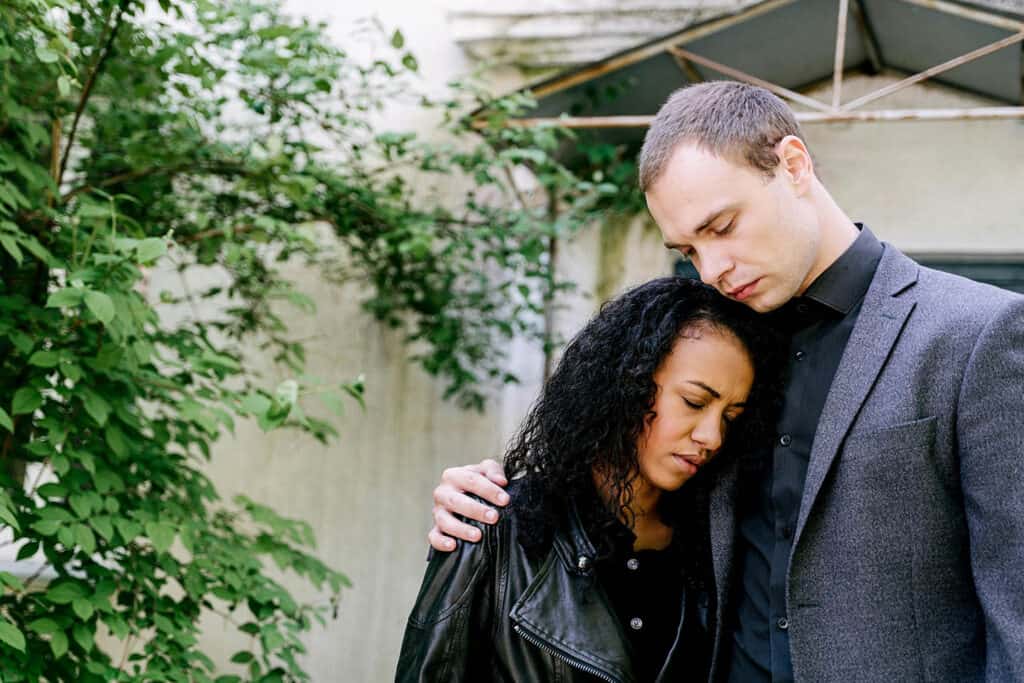

Have you ever found yourself deeply infatuated with someone, unable to see their faults or heed warnings from others?
If so, you’re not alone. Many people experience the allure of blind love, where emotions overpower reason.
With expertise in psychology and relationship dynamics, I’m here to help you decipher the difference between genuine affection and blind infatuation.
In this article, we’ll explore the signs of blind love, strategies to overcome it, and how to foster healthier relationships.
Let’s embark on this journey together to gain clarity and build relationships based on authenticity.
By the end, you’ll have the tools to distinguish between blind love and genuine connection, empowering you to cultivate fulfilling relationships grounded in mutual respect and understanding.
- 1. Defining Blind Love
- 2. The Illusion of Blind Love
- 3. 12 Signs of Blind Love
- 4. 12 Psychological Perspectives
- 5. 8 Cultural and Societal Influences
- 6. 12 Risks and Dangers
- 7. Literature, Film, and Art
- 8. Blind vs. Unconditional Love: 5 Differences
- 9. Blind Love and Self-Reflection
- 10. Blind Love and Empathy
- 11. Love With Eyes Wide Open
- 12. Blind Love and Boundaries
- What Is Blind Love: A Recap
Here are 12 signs and symptoms of blind love:
- Idealization: Viewing the person as flawless or perfect.
- Ignored Red Flags: Overlooking negative behaviors or warning signs.
- Excusing Behavior: Making excuses for harmful actions or mistreatment.
- Obsession: Constantly thinking about the person and prioritizing their needs above your own.
- Isolation: Withdrawing from friends and family to be with the person.
- Jealousy: Feeling possessive or threatened by others who interact with the person.
- Dependency: Relying heavily on the person for emotional validation or happiness.
- Fear of Losing Them: Constantly worrying about the possibility of the relationship ending.
- Tolerance of Abuse: Accepting mistreatment or abuse as normal or deserved.
- Lack of Boundaries: Allowing the person to cross personal boundaries without objection.
- Self-Neglect: Neglecting self-care or personal goals to prioritize the person’s needs.
- Resistance to Feedback: Dismissing concerns or criticisms from others about the relationship.
See also Personal Growth: A Journey of Personal Growth and Development
1. Defining Blind Love

Blind love in relationships encapsulates an intense emotional attachment without rational evaluation. Individuals in blind love often idealize their partner, overlooking flaws or red flags.
This romantic idealization can lead to disregarding the importance of understanding and accepting each other’s complexities.
Emotions override logic, causing individuals to ignore warnings of potential harm or incompatibility. Despite any wrongdoings or discrepancies, those in blind love persist, driven by the euphoria and excitement of romance. They prioritize the fleeting moments of joy and fun, often at the expense of long-term fulfillment.
Over time, as the relationship matures, individuals may begin to realize the limitations of blind love. Accepting flaws, gaining knowledge, and creating realistic expectations contribute to a healthier dynamic.
Ultimately, acknowledging the difference between blind love and genuine affection allows individuals to navigate relationships with clarity and authenticity.
2. The Illusion of Blind Love

The illusion of blind love often occurs when individuals idealize their partners and relationships, projecting fantasies onto them while ignoring underlying realities. At the beginning of a relationship, blind love can be filled with hope and excitement, as individuals imagine a future together.
However, this idealization can ultimately lead to disappointment and disillusionment when the realities of the person or relationship do not align with the fantasy created.
Blind love tends to deal more with the soul’s desires than with the body’s needs, often overlooking deeper compatibility issues. Blind love can mask red flags and prevent individuals from seeing the true nature of their partners or relationships, leading to potential heartbreak and turmoil within families.
3. 12 Signs of Blind Love

Signs and symptoms of blind love manifest in various ways within relationships. Often, a person in blind love may overlook red flags or ignore warning signs, believing their partner to be flawless.
This blindness can lead to repeating mistakes and engaging in unhealthy patterns, jeopardizing the well-being of the individual and the relationship.
Blind love blinds a person to the reality of their partner’s flaws and the potential dangers within the relationship.
Despite warnings from friends, family, or the community, they may persist in their infatuation, unable to see the truth.
This mental blindness overrides rational thinking, driven by intense emotions and attraction. Individuals must recognize these signs, step back, and reassess their feelings and decisions before it’s too late.
let’s take a moment to identify how many of these 12 signs and symptoms of blind love resonate with you and explore ways to overcome them
12 Signs, Symptoms and ways to overcome Blind Love
- Idealization: Viewing the person as flawless or perfect.
- How to Overcome: Practice realistic thinking by acknowledging and accepting your partner’s flaws. Make a list of their positive and negative traits to maintain a balanced perspective.
- Ignored Red Flags: Overlooking negative behaviors or warning signs.
- How to Overcome: Pay attention to behaviors that make you uncomfortable. Trust your instincts and discuss these concerns with a trusted friend or therapist for an objective viewpoint.
- Excusing Behavior: Making excuses for harmful actions or mistreatment.
- How to Overcome: Hold your partner accountable for their actions. Set clear expectations for respectful behavior and communicate your boundaries firmly.
- Obsession: Constantly thinking about the person and prioritizing their needs above your own.
- How to Overcome: Focus on your interests and hobbies. Schedule time for yourself and your friends to maintain a balanced life.
- Isolation: Withdrawing from friends and family to be with the person.
- How to Overcome: Reconnect with loved ones. Make an effort to spend time with friends and family to ensure your support network remains strong.
- Jealousy: Feeling possessive or threatened by others who interact with the person.
- How to Overcome: Build trust through open communication. Address your insecurities and work on developing self-confidence and mutual respect in the relationship.
- Dependency: Relying heavily on the person for emotional validation or happiness.
- How to Overcome: Cultivate your self-worth and happiness independently. Engage in activities that boost your self-esteem and create a support system outside of your relationship.
- Fear of Losing Them: Constantly worrying about the possibility of the relationship ending.
- How to Overcome: Focus on building a healthy and secure relationship. Practice mindfulness and self-assurance, and communicate your fears with your partner to foster trust.
- Tolerance of Abuse: Accepting mistreatment or abuse as normal or deserved.
- How to Overcome: Recognize that abuse is never acceptable. Seek help from a therapist or support group to understand your worth and learn how to establish healthy boundaries.
- Lack of Boundaries: Allowing the person to cross personal boundaries without objection.
- How to Overcome: Define your personal boundaries and communicate them clearly. Stand firm on your limits and enforce consequences if they are violated.
- Self-Neglect: Neglecting self-care or personal goals to prioritize the person’s needs.
- How to Overcome: Prioritize self-care and personal growth. Set aside time each day for activities that nurture your well-being and pursue your goals and aspirations.
- Resistance to Feedback: Dismissing concerns or criticisms from others about the relationship.
- How to Overcome: Be open to feedback from trusted friends and family. Reflect on their concerns and consider seeking a therapist’s guidance to gain an objective perspective on your relationship.
4. 12 Psychological Perspectives

Psychological Perspectives on Blind Love explain the complexities of romantic relationships, where individuals may fall into the trap of idealizing their partner, ignoring red flags, and overlooking harmful behaviors. At this stage, thinking becomes clouded by intense emotions, leading to a desire to fill perceived voids in one’s life.
Here’s a list of 12 psychological perspectives on blind love:
- Attachment Theory: Blind love may stem from insecure attachment styles, such as anxious or avoidant attachment, leading individuals to seek validation and security from others.
- Cognitive Bias: Blind love can be influenced by cognitive biases, such as confirmation bias, where individuals only see positive traits in the person they love while ignoring negative aspects.
- Emotional Dependency: Blind love may result from emotional dependency, where individuals rely on their partner for self-esteem and emotional stability.
- Fantasy and Projection: Blind love can involve projecting idealized fantasies onto the partner, creating an unrealistic image that does not reflect reality.
- Fear of Abandonment: Blind love may be driven by a fear of abandonment, causing individuals to cling to their partner despite harmful behaviors.
- Narcissistic Tendencies: Blind love can be associated with narcissistic tendencies, where individuals prioritize their own needs and desires over the well-being of their partner.
- Trauma Bonding: Blind love may develop in the context of trauma bonding, where individuals form strong emotional attachments to their abuser as a coping mechanism.
- Unmet Needs: Blind love may arise from unmet psychological needs, such as the need for love, acceptance, or validation, leading individuals to seek fulfillment in relationships regardless of the consequences.
- Projection of Self-Worth: Blind love may involve projecting one’s own sense of self-worth onto the partner, believing that their love validates their worthiness as a person.
- Unconscious Motivations: Blind love can be driven by unconscious motivations and unresolved psychological conflicts, influencing relationship dynamics without individuals’ awareness.
- Selective Perception: Blind love may involve selective perception, where individuals focus only on positive aspects of the relationship while ignoring or minimizing negative aspects.
- Influence of Media and Culture: Blind love can be influenced by societal norms and media portrayals of romantic relationships, shaping individuals’ expectations and behaviors in love.
See also Career and Wealth: Crafting a Fulfilling Career Path and Financial Wellness
5. 8 Cultural and Societal Influences

Cultural and societal influences play a significant role in shaping perceptions and experiences of blind love. Here’s how they impact:
- Norms and Expectations: Cultural norms dictate what is considered acceptable or desirable in romantic relationships. These norms may promote idealized notions of love, leading individuals to seek perfection in their partners and overlook flaws.
- Media Portrayals: Media, including movies, television shows, and literature, often romanticize love and depict relationships in unrealistic ways. This can create unrealistic expectations and contribute to the phenomenon of blind love, where individuals strive to emulate fictionalized romance.
- Social Pressures: Societal pressures to conform to traditional relationship ideals can influence individuals to prioritize romantic relationships above other aspects of their lives. This can lead to a reliance on romantic partners for validation and self-worth.
- Gender Roles: Gender roles and expectations within a culture can influence how individuals express and perceive love. For example, men may feel pressure to be stoic and unemotional, while women may feel pressured to prioritize their partner’s needs above their own.
- Family Dynamics: Family dynamics and upbringing can shape individuals’ beliefs and attitudes toward love and relationships. Dysfunctional family patterns, such as codependency or enmeshment, may contribute to blind love by fostering unhealthy relationship dynamics.
- Religious and Spiritual Beliefs: Religious and spiritual beliefs often include teachings about love, marriage, and relationships. These teachings can influence individuals’ perceptions of love and shape their expectations for romantic partners.
- Cultural Values: Cultural values related to love, commitment, and family vary widely across societies. These values influence relationship dynamics and may impact individuals’ willingness to tolerate or overlook negative aspects of a relationship in the name of love.
- Economic Factors: Economic factors, such as financial stability and social status, can influence relationship dynamics and individuals’ decisions about whom to love. In some cultures, financial considerations may take precedence over emotional compatibility in partner selection.
6. 12 Risks and Dangers

Blind love, while initially exhilarating, can lead to significant consequences, risks, and dangers in relationships. When individuals fall into blind love, they may overlook red flags or ignore their intuition, leading to unhealthy dynamics.
This can result in emotional turmoil, as feelings are suppressed or dismissed. Partners may feel misunderstood or unsupported, creating strain in the relationship.
Additionally, blind love can prevent personal growth and hinder individuals from realizing their full potential. Women, in particular, may face challenges in accepting or understanding their emotions, leading to a cycle of discontentment.
12 Risks and Dangers associated with blind love
- Abuse: Ignoring or excusing harmful behaviors from the partner.
- Manipulation: Being manipulated or controlled by the partner’s actions or words.
- Dependency: Becoming overly reliant on the partner for emotional validation or happiness.
- Isolation: Withdrawing from friends and family due to the influence of the relationship.
- Neglect: Neglecting personal well-being, goals, or responsibilities in favor of the relationship.
- Financial Exploitation: Being taken advantage of financially by the partner.
- Emotional Turmoil: Experiencing emotional distress or instability due to the relationship’s dynamics.
- Loss of Identity: Losing sight of one’s own values, interests, and priorities in the relationship.
- Stagnation: Remaining in a stagnant or unhealthy relationship rather than seeking growth or fulfillment.
- Jeopardizing Safety: Ignoring warning signs or red flags that may jeopardize one’s physical or emotional safety.
- Self-Doubt: Developing feelings of inadequacy or low self-esteem based on the partner’s actions or words.
- Limited Perspective: Having a narrow or skewed perspective on the relationship, ignoring outside feedback or alternative viewpoints.
7. Literature, Film, and Art

Blind love is a recurring theme in literature, film, and art, often portraying the intensity and complexities of relationships.
Characters tend to begin their journey filled with hope, imagining a deep connection with their partner. However, as the story progresses, the dangers of blind love unfold.
Mistakes are made, and consequences are faced, highlighting the risks involved in navigating relationships without clarity and awareness.
Whether it’s a romantic relationship, family bonding, or community ties, blind love can have profound impacts on individuals and society as a whole.
Artists, filmmakers, and authors use their craft to depict the dangers and decisions inherent in blind love, urging audiences to examine their own relationships with open eyes.
8. Blind vs. Unconditional Love: 5 Differences

- Blind love involves ignoring red flags or warning signs, while unconditional love recognizes and addresses issues.
Example: In blind love, someone might ignore signs of their partner’s abusive behavior, excusing it as mere passion. However, in unconditional love, these signs would prompt a conversation or action to address the behavior. - Blind love prioritizes the positive aspects of the person, whereas unconditional love accepts both positive and negative traits.
Example: Blind love might ignore a partner’s irresponsible spending habits, focusing only on their charm. In contrast, unconditional love would acknowledge the charm but also discuss and address the financial issues together. - Blind love can be superficial and fleeting, but unconditional love is deep and enduring.
Example: Blind love might fade when external circumstances change, such as financial difficulties. However, unconditional love remains steadfast through challenges, growing stronger over time. - Blind love may result in a lack of true emotional connection, while unconditional love builds deep connections and emotional growth.
Example: In blind love, partners may not truly understand each other’s emotional needs, leading to a superficial connection. However, in unconditional love, partners communicate openly, fostering deeper emotional bonds. - Blind love may not fully acknowledge or accept the flaws of the loved one, while unconditional love acknowledges and embraces those flaws.
Example: Blind love might gloss over a partner’s temper issues, attributing them to stress. Conversely, unconditional love recognizes the temper but offers support and understanding to help manage it.
9. Blind Love and Self-Reflection

Blind love often leads individuals to overlook red flags and idealize their romantic partner, blinding them to potential issues within the relationship. Self-reflection becomes crucial in such scenarios, prompting individuals to examine their feelings, perceptions, and behaviors. By taking a step back and engaging in introspection, one can gain clarity on the dynamics of their relationship and assess whether their love is truly reciprocated and healthy.
Self-reflection enables individuals to question their motivations, values, and expectations, helping them discern between genuine affection and infatuation.
It empowers individuals to make decisions based on reality rather than fantasy, personal growth, and fulfillment. Through open communication and honest dialogue, partners can navigate blind love together, ensuring that their relationship is grounded in mutual respect, understanding, and authenticity.
10. Blind Love and Empathy

Blind love often intertwines with empathy, creating a delicate balance in relationships and lives. When a person is falling into blind love, their empathy may overshadow rationality, leading them to prioritize their partner’s needs over a head of their own.
Blind love and empathy are interconnected but distinct concepts:
Blind Love:
- Blind love refers to love that is based on infatuation, idealization, or fantasy, where individuals overlook flaws or negative traits in the person they love.
- It involves prioritizing the positive aspects of the person while ignoring red flags or warning signs in the relationship.
- Blind love can lead to unhealthy relationship dynamics and may involve dependency, manipulation, or abuse.
Empathy:
- Empathy, on the other hand, is the ability to understand and share the feelings of another person. It involves putting oneself in someone else’s shoes and experiencing their emotions from their perspective.
- Empathy is an essential component of healthy relationships, as it fosters understanding, compassion, and connection between individuals.
- Unlike blind love, empathy involves recognizing and acknowledging both the positive and negative aspects of a person, including their strengths, weaknesses, and struggles.
They may overlook red flags or dismiss concerns raised by others, believing their romantic partner deserves unwavering loyalty. However, empathy in blind love can be dangerous if it veers into enabling harmful behavior or neglecting one’s well-being and not thinking with your brain. I
t’s crucial to strike a balance between empathy and discernment as a sign, ensuring that both partners respect each other’s boundaries, and make decisions and rest collaboratively.
11. Love With Eyes Wide Open

“Love With Eyes Wide Open” signifies a conscious approach to relationships, where individuals actively assess their romantic partnerships with clarity and awareness. Instead of forgetting and being blinded by infatuation or idealization, they scrutinize their partner’s actions, intentions, and compatibility with a clear mind.
This approach involves acknowledging both the positive and negative aspects of the relationship, and understanding that love alone does not suffice to sustain a healthy partnership. It requires open communication, mutual respect, dealing with situations, talking to each other, and alignment of values and goals.
By keeping their eyes open, individuals can make informed decisions about their romantic lives, recognizing when a relationship may not be serving their best interests so that they can stop loving the wrong partner. They figure and prioritize their well-being and happiness, refusing to settle for less than they deserve in their life.
See also Work-Life Balance: Strategies for Achieving Harmony in Work and Life
12. Blind Love and Boundaries

Blind love often blurs boundaries, leading individuals to prioritize their romantic partner’s needs over their own. At the beginning of a relationship, it’s easy to imagine a world where love conquers all. However, as the season changes, the reality of maintaining personal boundaries becomes apparent.
In blind love, individuals may forget to prioritize self-care, hoping their partner will fulfill all their needs. This can lead to a cycle of wrong expectations and disappointment in the country. To deal with blind love, it’s crucial to decide what matters most in life and deserve partners who respect boundaries. Remember, falling in love shouldn’t mean losing oneself in the process.
What Is Blind Love: A Recap

Blind love, from the beginning, often stems from a hopeful soul envisioning an idealized version of love. It bypasses rationality, captivating the heart and clouding the mind and body.
At this point, individuals may imagine a world where their romantic partner fulfills every desire and need.
However, like a change of season, the reality of blind love unfolds. Individuals may find themselves dealing with unmet expectations and disappointment, realizing that love alone cannot sustain a relationship.
In this social experiment, it’s essential to decide what truly matters in life and to set boundaries with partners.
Blind love often involves sacrificing one’s own needs and desires for the sake of the relationship and partners, but it’s crucial to remember that love shouldn’t come at the expense of one’s well-being.
Ultimately, navigating blind love requires introspection, communication, and a willingness to prioritize both the heart and the head in matters of the heart.


